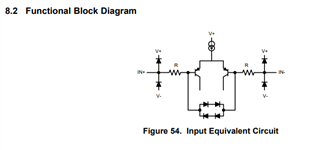Hello,
I'm analyzing the worst case output voltage error that could be due to the input bias current of the LMH6643. I believe the offset voltage error should be equal to the bias current flowing into IN- times the negative feedback resistor. I see the datasheet specifies a negative input bias current along with the note "Positive current corresponds to current flowing into the device."
My question is, for this particular op amp, could the input bias current flowing into IN- ever be a positive value? Or will the bias current for all LMH6643 parts be negative? Since IN- seems to connect internally to the base of a PNP transistor, it seems intuitive that the leakage current would always flow in one direction, but I want to be sure as both the + and - voltage error matter for this application.
Thanks,
Ben


